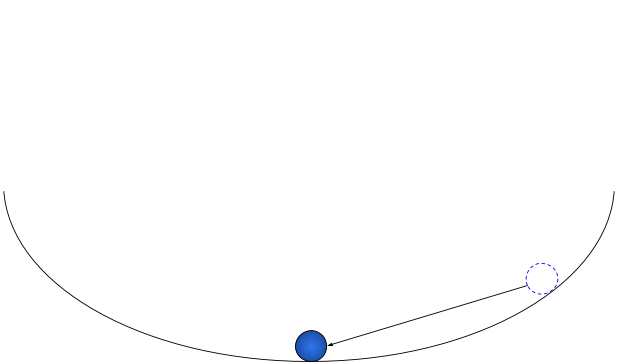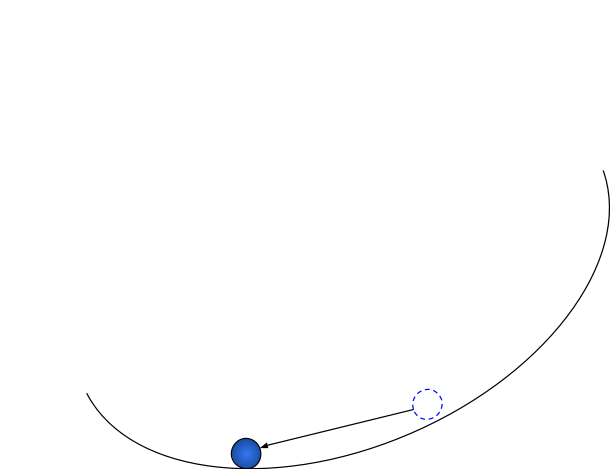This is a framing practicum post. We’ll talk about what a stable equilibrium is, how to recognize stable equilibria in the wild, and what questions to ask when you find one. Then, we’ll have a challenge to apply the idea.
Today’s challenge: come up with 3 examples of stable equilibrium which do not resemble any you’ve seen before. They don’t need to be good, they don’t need to be useful, they just need to be novel (to you).
Expected time: ~15-30 minutes at most, including the Bonus Exercise.
What’s a Stable Equilibrium?
Put a marble at the bottom of a round bowl, and it will just sit there without moving. Put it in the bowl but not quite at the bottom, and it will roll around a bit, but eventually settle at the bottom, and sit there without moving. Give it a poke, and it will roll around some more, but eventually it will again sit at the bottom without moving.
This is stable equilibrium: the system may start in different states, or it may be “perturbed” into different states by some external force, but eventually it settles back to the same state (assuming it isn’t pushed too far away…).

What To Look For
Stable equilibrium should spring to mind whenever a system tends to return to the same state. If you could “poke” it somehow, and the system would go back to normal eventually, that’s probably a stable equilibrium. If a system tends to stay suspiciously the same over the long run, despite lots of short-run noise, that’s probably a stable equilibrium.
Useful Questions To Ask
The marble always returns to the bottom of the bowl. If we push the marble away from the bottom, that’s only a short-term change - it will roll back down eventually. So, if we’re mainly interested in the long run behavior of the marble, then we can ignore such little pushes.
On the other hand, there may also be ways to change the equilibrium state itself. For instance, if we tip the bowl to the side slightly, then the equilibrium position of the marble will change. If we deform the bowl, that could change equilibrium position. If we charge the marble with a little static electricity, then place another charged object near the bowl, that could also change the equilibrium. Finally, very large changes to the system state could push it out of the bowl entirely.

When we frame something as a stable equilibrium, we ignore temporary changes to the system state, and only pay attention to things which change the equilibrium.
Two main ways this can apply:
- We want to change the long-term behavior of a system. So, we focus on things which can change the equilibrium, and ignore things which don’t.
- We see a change in the long-term behavior of a system, and want to know what caused it. So, we focus on things which can change the equilibrium, and ignore things which don’t.
The Challenge
(Rules adapted from the Babble Challenges)
Come up with 3 examples of stable equilibrium which do not resemble any you’ve seen before. They don’t need to be good, they don’t need to be useful, they just need to be novel (to you). I recommend mentioning what the equilibrium is, and a few ways you could “poke” the system for which it would return to equilibrium afterwards, so that everyone understands your example.
Any answer must include at least 3 to count, and they must be novel to you. That’s the challenge. We’re here to challenge ourselves, not just review examples we already know.
However, they don’t have to be very good answers or even correct answers. Posting wrong things on the internet is scary, but a very fast way to learn, and I will enforce a high bar for kindness in response-comments. I will personally default to upvoting every complete answer, even if parts of it are wrong, and I encourage others to do the same.
Post your answers inside of spoiler tags. (How do I do that?)
Celebrate others’ answers. This is really important, especially for tougher questions. Sharing exercises in public is a scary experience. I don’t want people to leave this having back-chained the experience “If I go outside my comfort zone, people will look down on me”. So be generous with those upvotes. I certainly will be.
If you comment on someone else’s answers, focus on making exciting, novel ideas work — instead of tearing apart worse ideas. Yes, And is encouraged.
Reward people for babbling — don’t punish them for not pruning.
I will remove comments which I deem insufficiently kind, even if I believe they are valuable comments. I want people to feel encouraged to try and fail here, and that means enforcing nicer norms than usual.
If you get stuck, look for:
- Systems which go back to normal after you poke them
- Systems which stay suspiciously the same over time despite lots of short-term noise
Bonus Exercise: for each of your three examples from the challenge, suppose you want to change the equilibrium, or you want to know what caused a change in the equilibrium. What factors should you pay attention to (since they can change the equilibrium)? What factors can you safely ignore (since they only affect the system in the short term)?
This bonus exercise is great blog-post fodder!
Motivation
Much of the value I get from math is not from detailed calculations or elaborate models, but rather from framing tools: tools which suggest useful questions to ask, approximations to make, what to pay attention to and what to ignore.
Using a framing tool is sort of like using a trigger-action pattern: the hard part is to notice a pattern, a place where a particular tool can apply (the “trigger”). Once we notice the pattern, it suggests certain questions or approximations (the “action”). This challenge is meant to train the trigger-step: we look for novel examples to ingrain the abstract trigger pattern (separate from examples/contexts we already know).
The Bonus Exercise is meant to train the action-step: apply whatever questions/approximations the frame suggests, in order to build the reflex of applying them when we notice a stable equilibrium.
Hopefully, this will make it easier to notice when a stable equilibrium frame can be applied to a new problem you don’t understand in the wild, and to actually use it.
Thankyou to Sisi, Eli, Adam and especially Jacob for beta-testing and feedback. Also thankyou to Aysajan for our daily discussions, which led to this concept.